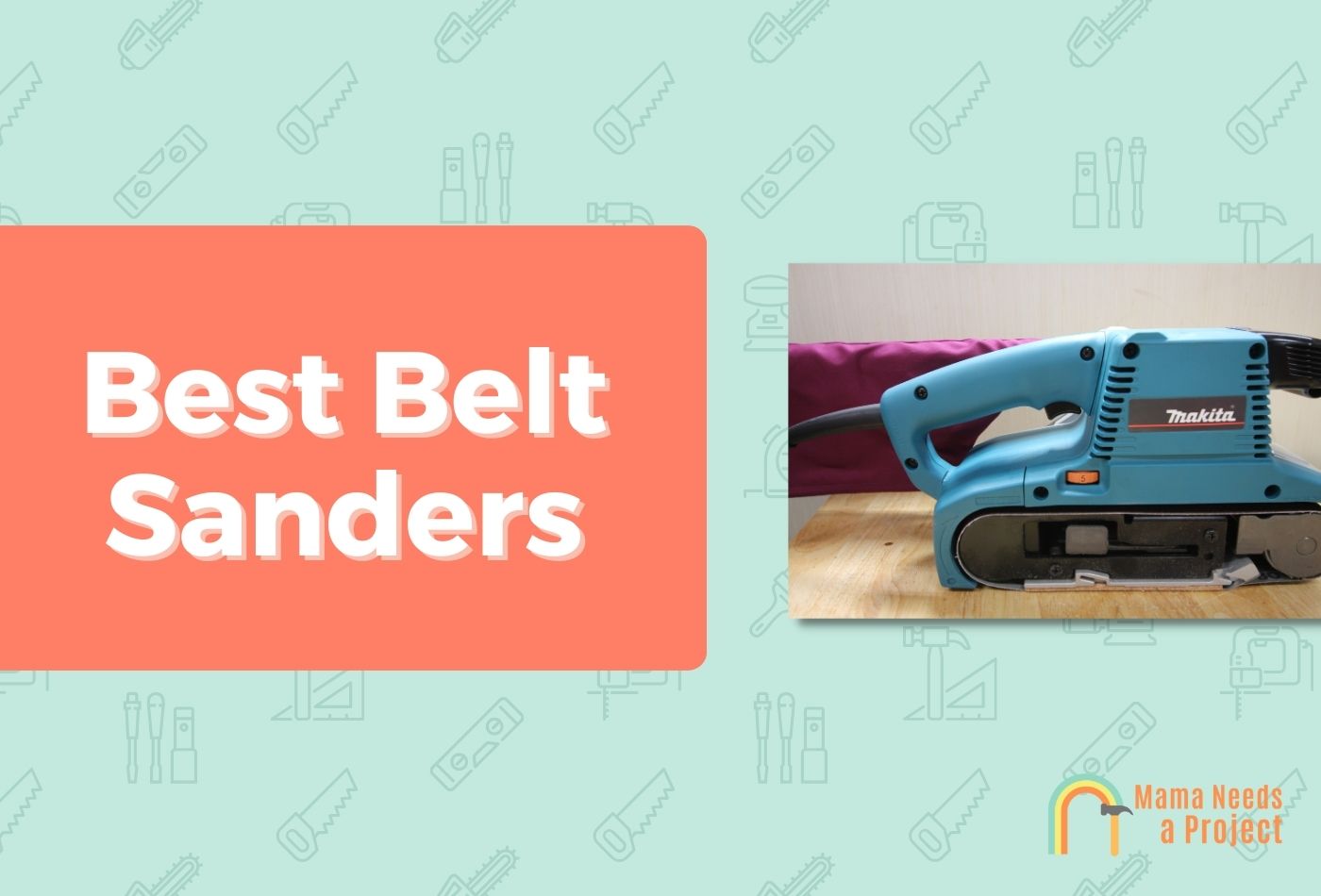I Tested 7 Belt Sanders: Here are the Best (2024)
Belt sanders can be some of the most convenient tools for quickly removing any finish from a wood surface. But it can be tough to find the right one for your project!
I’ve used several of the most popular sanders on the market in my years of woodworking and home projects so I’m here to help! Here are the best belt sanders that I love!
In a hurry? The best belt sander overall is the Makita belt sander. This sander is powerful enough for any job and works great on decks, furniture, and any wood surface.

We’re committed to providing unbiased reviews of products that are thoroughly tested based on a multitude of factors. We do not consider affiliate relationships when determining how to choose or rank products. Read more about our reviews process here. Have questions? Email reviews@mamaneedsaproject.com for more info.
- 9+ sanders thoroughly vetted and hand tested
- 17+ data points and key considerations
- 40+ hours of use and analysis
Best Belt Sanders
- Makita Belt Sander – #1 Best Overall
- Metabo HPT Belt Sander – Best Belt Sander for Woodworking
- SKIL Belt Sander – Best Belt Sander for the Money
- Ryobi 18V Belt Sander – Best Cordless Belt Sander
- Craftsman Belt Sander – Best Lightweight Belt Sander
- Makita 3/8 x 21″ Belt Sander – Best Mini Belt Sander
- BUCKTOOL 4″ x 36″ Benchtop Belt Sander – Best Benchtop Belt Sander
Compare the Top Belt Sanders
| Product | Max Speed | Size | Motor | Warranty | Read Review |
|---|---|---|---|---|---|
| Makita Belt Sander | 1,640 FPM | 4″ x 24″ | 11 amps | 1-year | See Review ↓ |
| Metabo HPT Belt Sander | 1,475 FPM | 3″ x 21″ | 9 amps | 5-years | See Review ↓ |
| Skil Belt Sander | 900 FPM | 3″ x 18″ | 6 amps | 2-years | See Review ↓ |
| Ryobi 18V Belt Sander | 850 FPM | 3″ x 18″ | 18V | 3-years | See Review ↓ |
| Craftsman Belt Sander | 800 FPM | 3″ x 21″ | 7 amps | 3-years | See Review ↓ |
| Makita Mini Belt Sander | 5,600 FPM | 3/8″ x 21″ | 4.4 amps | 1-year | See Review ↓ |
| BUCKTOOL Benchtop Belt Sander | 2,161 FPM | 4″ x 36″ | 5 amps | 2-years | See Review ↓ |
1. Makita 9403 Belt Sander – #1 Best Overall
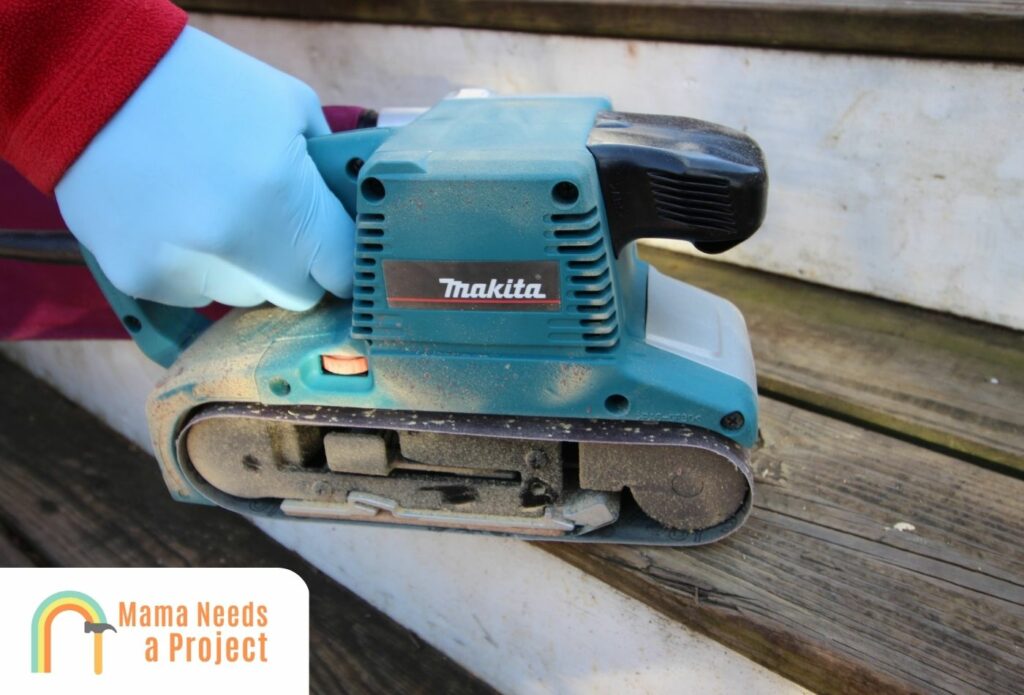
If you’re looking for the best belt sander you can buy – go with the Makita 4″ x 24″ belt sander. It’s one of the most powerful belt sanders you can opt for making it extremely effective at removing any finish on your wood surface.
You’ll get up to 1,640 FPM of sanding speed which means you can tackle even the largest projects without having to spend all day sanding.
The dust collection bag does a decent job of keeping your area free and clear of sanding dust although it’s not perfect.
The sanding belt is extremely easy to change and I found that it lasts for quite some time before having to be changed.
What I Liked:
- Extremely powerful and durable 11 amp motor
- Larger size makes sanding faster
- Comfortable and easy to use
What I Didn’t Like:
- Much heavier compared to other belt sanders
- More expensive than other sanders
My Thoughts:
Overall, if you want the best belt sander you can get your hands on, go with this Makita Belt Sander. It’s extremely powerful and does an amazing job on any wood surface making it the best sander for decks, hardwood floors, and even smaller projects like furniture and cabinetry.
More Stores
2. Metabo HPT Belt Sander – Best Belt Sander for Woodworking
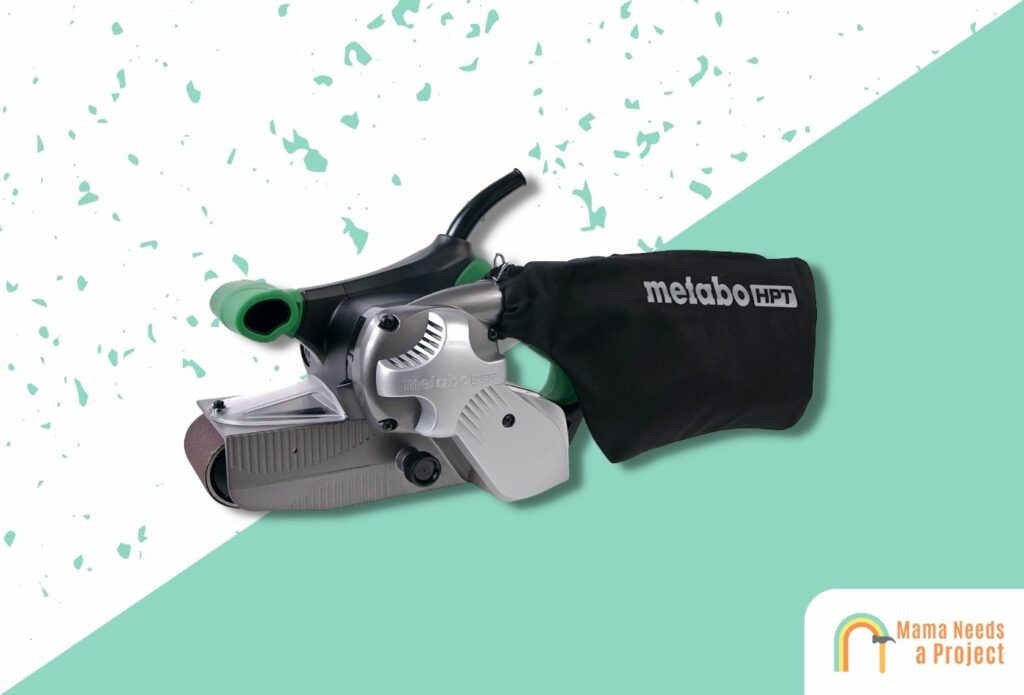
If you’re looking for a sander for woodworking projects – this Metabo HPT Belt Sander is a great option. With a 9 amp brushless motor, this belt sander is capable of speeds up to 1,475 FPM which allows you to get a lot done in little time.
The variable speed dial is super easy to adjust with 5 settings that allows you to get the exact speed you want.
You’ll also get an extended 5-year warranty that really speaks to the build quality which I love.
What I Liked:
- Powerful motor and great speed for large projects
- Extremely comfortable design and rubberized grip makes it easy to control
- Extremely long 5-year warranty
- Pretty good value for the price
What I Didn’t Like:
- Heavier than other sanders
- Dust collection isn’t quite as good as the Makita sander
My Thoughts:
The Metabo HPT Belt Sander is the perfect belt sander for woodworking because it’s powerful, fast, and effective. This handheld belt sander will have no trouble stripping paint for any finish on your wood projects. While it’s slightly smaller and less powerful than the Makita sander above, it’s still a tremendous choice for woodworkers.
More Stores
3. SKIL Belt Sander – Best Budget Belt Sander for the Money
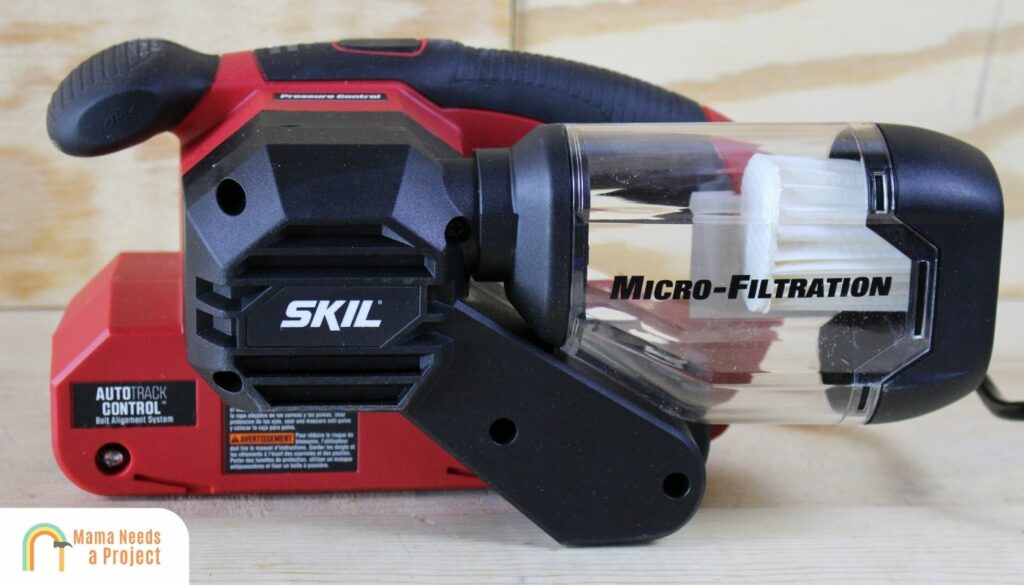
If you need a belt sander on a budget, the SKIL belt sander is an amazing choice that I’m a huge fan of. It’s the best belt sander under $100 and is very capable for the price.
This belt sander is a versatile sander that works for virtually any task. Whether you need to restain your deck or sand some furniture – this SKIL belt sander is a strong choice.
While it doesn’t have the power that other belt sanders feature, you’ll still get up to 1,050 FPM of speed which is quite fast and the dual grip handle is extremely comfortable.
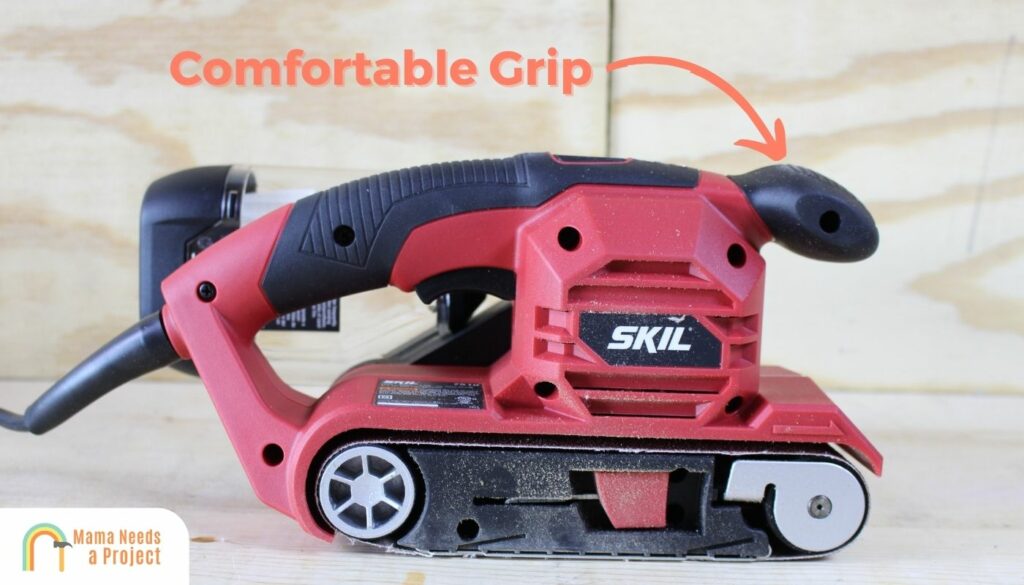
I love the transparent dust canister that is easy to see when it has filled and needs to be emptied. Also, the auto tracking belt system ensures the belt stays centered for a more accurate sanding job.
What I Liked:
- Great value for the price
- You can easily to see when the sanding container is full
- Auto centering belt system keeps belt aligned correctly
- Lightweight design doesn’t cause as much shoulder fatigue
What I Didn’t Like:
- Not as powerful as other sanders
My Thoughts:
The best belt sander for the money is the SKIL belt sander. With this sander, you’ll get a more lightweight sander that can still perform many of the same jobs that heavier more expensive models offer, but at a lower price. It does a decent job with dust collection but in my opinion the standout feature of this sander is the transparent dust canister. While you might not think of this as a big deal, it allows you to easily tell when it needs to be emptied so you aren’t playing guessing games with your sander. Also, because it’s a more light duty sander – you don’t get nearly as much shoulder and arm fatigue with this one which is super nice.
More Stores
4. Ryobi 18V Belt Sander – Best Cordless Belt Sander
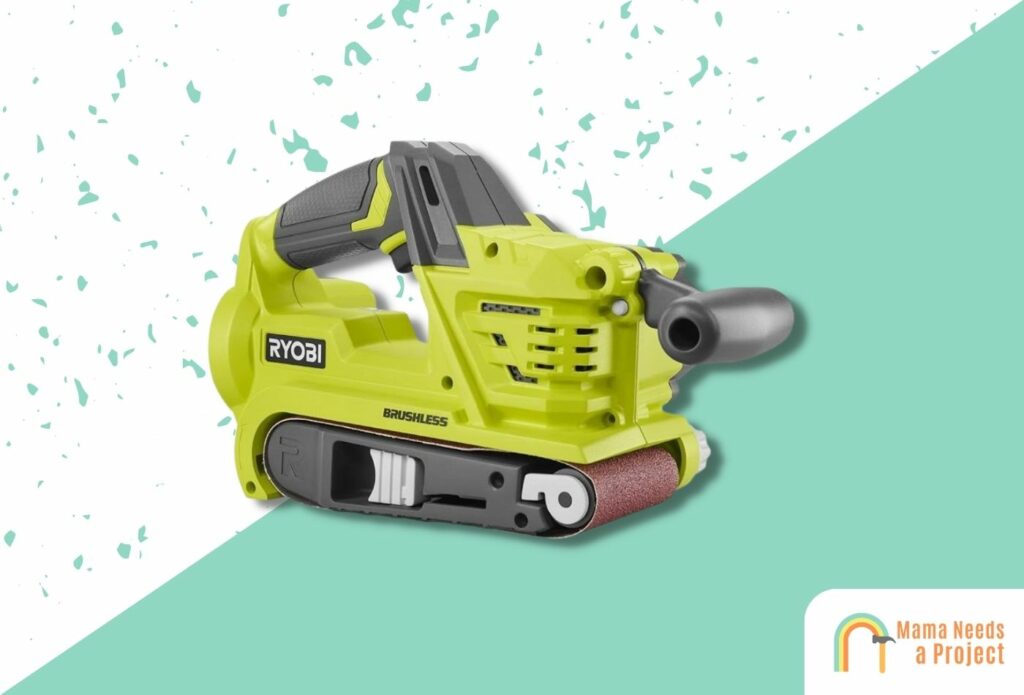
If you’re looking for a cordless belt sander, this Ryobi 18V belt sander is a terrific choice that’s perfect for a wide range of projects.
The brushless motor provides more than enough power for a wide range or projects and produce speeds up to 850 FPM of belt speed.
I found that the battery life was quite good considering how much power these sanders can use so you can expect to get around 20 minutes or more of consistent sanding before needing a charge.
It’s comfortable, easy to use, and it’s compatible with other Ryobi cordless products so you can easily swap out batteries if you have them handy.
What I Liked:
- No cords can get in the way of your sanding
- Battery life seemed quite strong for basic sanding jobs
- Can swap out batteries with other Ryobi cordless tools
- Very comfortable adjustable grip makes it easier to maneuver
What I Didn’t Like:
- Not quite as powerful as a corded belt sander
- A little heavy because of the battery
My Thoughts:
The Ryobi 18V Cordless Belt Sander is the best cordless handheld belt sander you can buy. While cordless belt sanders don’t offer the same power as corded belt sanders, it’s still more than enough for everyday sanding jobs. I am a big fan of the adjustable grip so you can really dial in the position of your hand and reduce fatigue. It’s also priced better when compared to other cordless handheld belt sanders and has an extended 3-year warranty that’s a nice plus.
More Stores
5. Craftsman Belt Sander – Best Lightweight Belt Sander
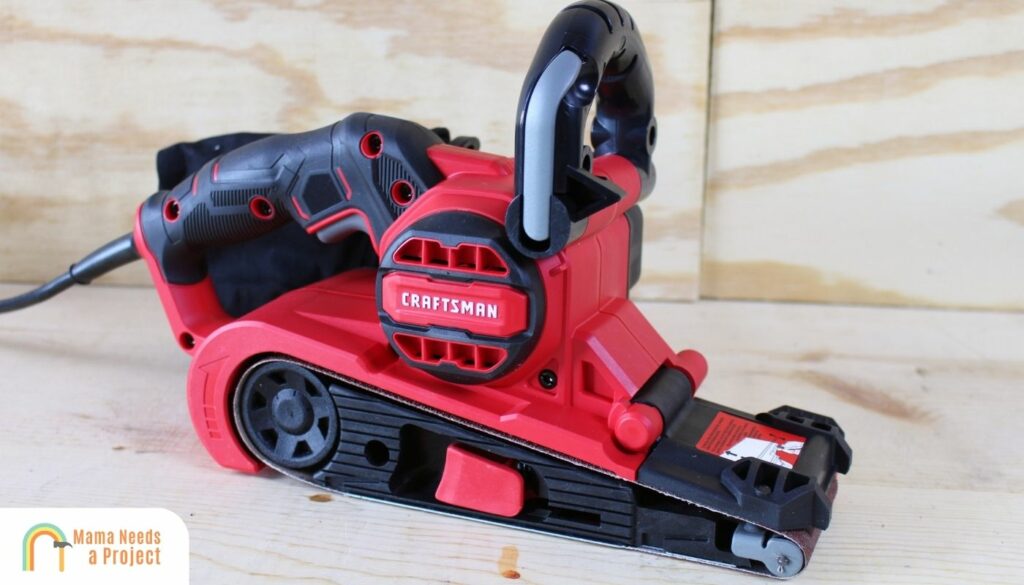
Another great belt sander that won’t break the bank is the Craftsman 3″ x 21″ Corded Belt Sander. This sander features a 7 amp motor that offers a surprisingly large amount of power despite its more affordable price.
While you only get a maximum 800 FPM of speed, this sander can chew through any existing finish without a problem.
The grip is easy to adjust and I didn’t have any problems with the dust collection bag or changing sanding belts.

What I Liked:
- Powerful 7 amp motor has no trouble removing paints and finishes
- Not overly heavy making it easy to move around
- Longer 3-year warranty
What I Didn’t Like:
- Slower speed than other corded belt sanders
- No variable speed control
My Thoughts:
Overall, the Craftsman 3″ x 21″ belt sander is the best belt sander under $100. The belt size is just right and it has plenty of power for the toughest jobs. It also comes with a slightly longer 3-year warranty that’s gives you a little extra peace of mind, but I never ran into any issues when using this sander. It’s worth noting that this model doesn’t have variable speed settings, which is worth considering depending on your project – but I didn’t run into any issues with this while using it on decking.
More Stores
6. Makita 3/8″ x 21″ Belt Sander – Best Mini Belt Sander
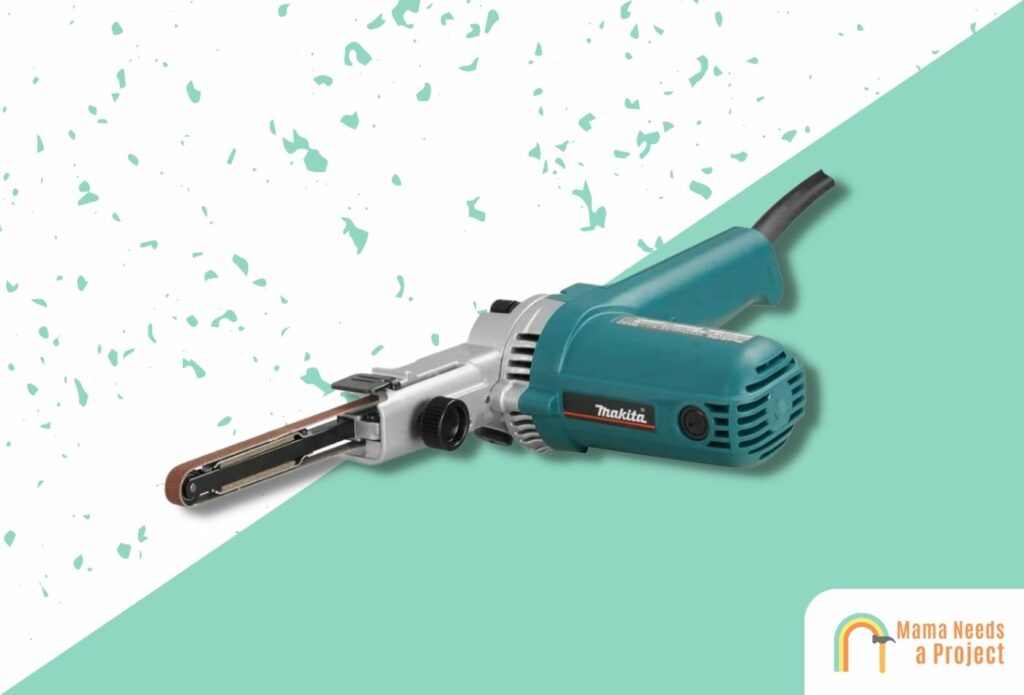
Need a mini belt sander for detailed work? The Makita belt sander is a high quality belt sander that’s built to last.
This belt sander comes with a slimmer 3/8″ belt than the Makita sander above which allows you to easily sand smaller more intricate pieces.
But don’t get me wrong, just because it’s smaller in size, it still packs a punch. The 4.4 amp motor does a great job of giving you more than enough power for small sanding projects and the variable speed dial offers great control.
Because of its smaller size, this is also one of the quietest belt sanders on my list, which could be important to you.
What I Liked:
- Swiveling arm allows you to reach tighter spaces and areas
- Extremely powerful sander
- Variable speed dial allows for great control
What I Didn’t Like:
- More expensive than other models
- Smaller than other sanders
My Thoughts:
If you’re looking for the best mini belt sander, go with the Makita 3/8″ x 21″ belt sander. This will allow you to sand all of those smaller pieces, but it’s still has all of the power you need to remove paints and finishes from your surface. And you’ll love the extending arm that allows you to position the sanding belt wherever you need. My only complaint is the price, but you’re paying for a top quality sander that’s going to last.
More Stores
7. BUCKTOOL 4″ x 36″ Benchtop Belt Sander – Best Benchtop Belt Sander
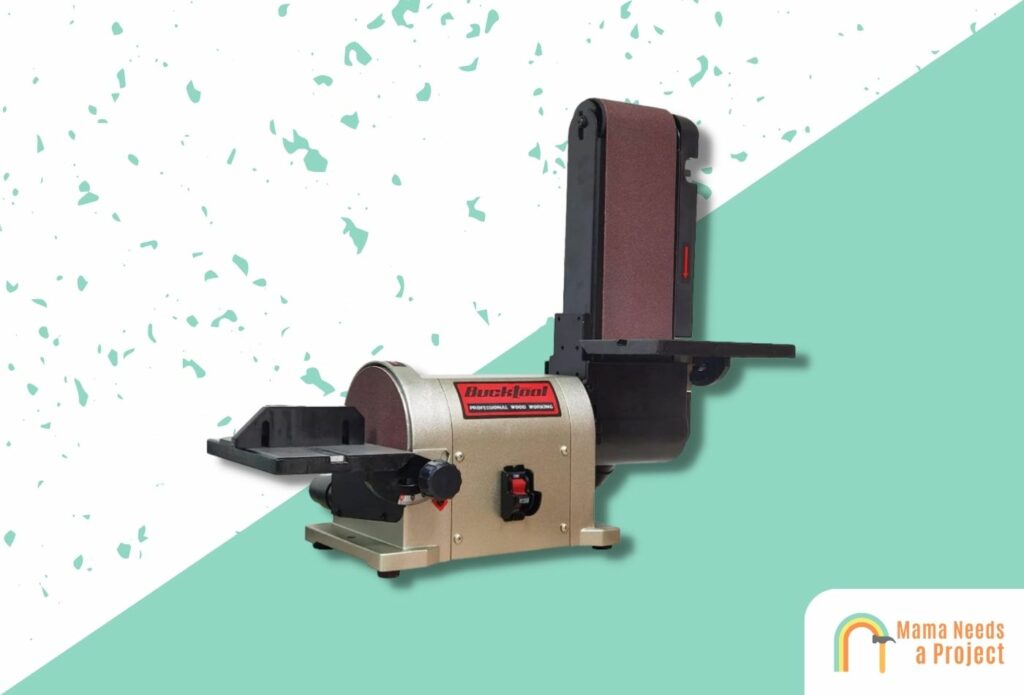
If you’re looking for a benchtop belt sander, the BUCKTOOL 4″ x 36″ benchtop belt sander is the way to go.
Benchtop belt sanders can be super handy for some projects because you don’t have to move the sander around. Instead, you just position your workpiece on the sander and move it around as needed.
Because of this, you won’t be able to sand decking or floors with a stationary belt sander, but they’re perfect for some woodworking projects.
This belt disc sander features a powerful direct drive 5 amp motor and can reach speeds of 2,161 FPM for the belt and 3,450 RPM for the disc sander.
Finally, this 26” x 5” x 12”, 42 lbs mini wood lathe is backed by a two-year limited warranty and a 30-day satisfaction guarantee. Therefore, if you don’t like the product, you have thirty days to return it for a refund.
What I Liked:
- Can adjust it for vertical sanding or horizontal sanding
- Base is heavy enough so you don’t have to worry about it tipping over
- Pretty good value for the price
- Dual belt and disc sander for more versatility
What I Didn’t Like:
- More difficult to change sanding belt than handheld belt sanders
My Thoughts:
If you need a stationary belt sander, this BUCKTOOL sander is one of the best belt sanders you can buy. It has all of the power you need with a heavy enough base so you don’t have to worry about it falling over. It’s also a pretty good value considering the price.
More Stores
What to Consider When Buying a Belt Sander
Power & Speed
As with all power tools, the amount of power your sander offers is a critical feature that can make or break your sander. More powerful sanders will be able to remove more paint or finish from your wood without a problem.
Less powerful sanders can get bogged down and begin to overheat under too much stress which is why a powerful sander is important.
Speed is another important consideration when choosing a handheld belt sander. If your sanding belt spins too fast, you can remove too much material and damage the wood. If your sander doesn’t spin fast enough, you might not be able to remove much material at all.
The best belt sanders will allow you to control the speed of your belt to match your needs so you can get the perfect finish every time.
Control, Comfort, and Ease of Use
Control and comfort are also worth considering when considering belt sanders.
Most belt sanders will feature a variable speed setting so that you can easily control how fast your sanders belt spins.
As far as comfort is concerned, many handheld models will have some sort of added grip in addition to a place for your hand where the trigger is located. This added grip can make it easier to move around while you’re working.
Finally, how simple the sanding belt is to change should be considered. Some will allow you to change the belt without the need for any tools making it super fast and easy. Others might require a bit more work, which can be frustrating after working on a project for hours.
Size and Weight
Belt sanders come in many shapes and sizes. So depending on your project, you’ll want to consider which size is best for you.
For example, some belt sanders come with smaller, thin belts whereas some have thicker belts that are better suited for sanding larger surfaces.
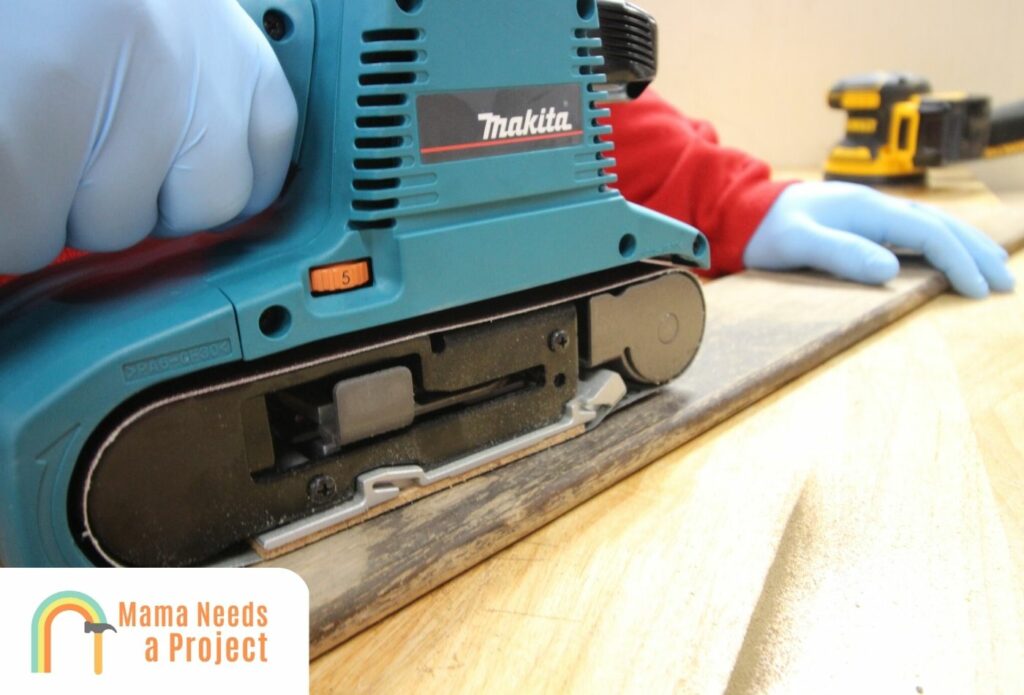
And don’t forget about weight!
The weight of your sander plays a huge role in how comfortable and easy it is to use. The heavier the sander, the more difficult it can be to move around and your should can begin to fatigue.
If you’re sanding vertical surfaces, the weight of your sander is vital to ensure your arm and shoulder don’t get fatigued before you’ve finished sanding.
Dust Collection
Dust collection is another overlooked component that many people take for granted. Dust collection not only plays a big role in how smooth of a surface you get, but it also helps reduce the risk of inhaling dust particle and ensuring the longevity of your sander.
Most handheld belt sanders will have a dust bag or canister that gathers dust and removes it from the surface as you sand. Once full, you’ll need to empty the dust bag
Not all sanders can absorb dust equally, though. Some do a much better job than others.
Corded vs Cordless
From my years of DIY projects, I’ve come to appreciate both corded and cordless belt sanders.
Corded sanders offer consistent power and are ideal for extended use or heavy-duty tasks. You never worry about them running out of juice during a critical job, which is a big plus.
On the other hand, cordless belt sanders grant unparalleled mobility, perfect for on-site tasks or when an outlet isn’t nearby. However, they’re reliant on battery life, which can be limiting during prolonged use.
For stationary or intensive tasks, I’d opt for a corded model. But for convenience and portability, a cordless sander can be a game-changer.
Benchtop vs Handheld Sanders
Wondering if you should go with a benchtop or handheld belt sander?
Benchtop sanders provide stability and precision, making them indispensable for intricate or repetitive tasks. When you need uniformity or you’re working on small parts, the benchtop sander is my go-to.
Meanwhile, handheld sanders offer flexibility and adaptability. They’re perfect for larger projects or areas that demand mobility. When I’m working on a big tabletop or tackling an uneven surface, a handheld sander becomes my trusted ally.
So, for precise, stationary tasks, I would lean towards benchtop models, but for broader applications, nothing beats the convenience of handhelds.
Additional Features
Additional features such as a locking trigger, automatic pressure sensors, and a dust port should also be considered when making your purchase.
While these may not be make it or break it features – they can certainly be a tie breaker.
Additionally, some sanders are sold with sanding belts included, while others you may need to purchase separately.
Price & Warranty
When it comes to price and warranty, there’s certainly a wide range of offerings depending on your budget and projects.
You can find some belt sanders under $100 while some can cost over $300. Remember, depending on how often you use your sander, spending some extra money might be worth it.
In terms of warranties offered, most will come with a 1 to 3-year warranty while some might offer warranties for as long as 5-years.
Tips When Using a Belt Sander
- Test your sander first: Before going all out with your sander, test it out on a scrap piece of wood or an area that’s not as important. This will give you a better idea of how much material it removes so you can avoid any mistakes.
- Start with a Coarse Grit: Begin sanding with a coarse grit to quickly remove material, then work your way to finer grits for a smoother finish. This step-by-step progression ensures both efficiency and a refined result that you’re looking for.
- Move in the Direction of the Grain: Sanding wood along its grain minimizes scratches and promotes a uniform finish. Going against the grain can leave unsightly marks that you don’t want.
- Keep the Sander Moving: Holding the sander in one place for too long can gouge the surface so you should ensure you’re always moving to avoid creating divots or uneven spots.
- Apply Even Pressure: Let the sander do the work. Applying too much pressure doesn’t necessarily speed up the process and can wear out your sanding belts quicker as well as cause unnecessary wear and tear on your sander.
- Regularly Check the Belt: Ensure the belt isn’t clogged with debris, and replace worn-out belts. A clean, sharp belt works more efficiently and provides a better finish.
- Stay Balanced: Make sure the sander stays flat against the surface. Tilting or rocking can create uneven areas or gouges that can’t be difficult to fix.
- Use Safety Gear: Safety gear is critical to keep yourself safe, especially when using a belt sander. You’ll want to wear a respirator to avoid inhaling any sanding dust and it’s a good idea to wear an apron to keep your clothes clean.
Final Thoughts
Overall, the best belt sander is the Makita 9403 Belt Sander. This is an extremely capable belt sander that does an amazing job of removing any paint or finish on your wood.
If you’re looking for a budget friendly belt sander, go with the SKIL belt sander. It’s a versatile sander that’s perfect for homeowners and DIYers on a budget.
If you need a belt sander for woodworking, you can’t go wrong with the Metabo HPT Belt Sander. This is a powerful and effective sander that’s perfect for woodworking projects.
Looking for other sanders? Check out these guides!

